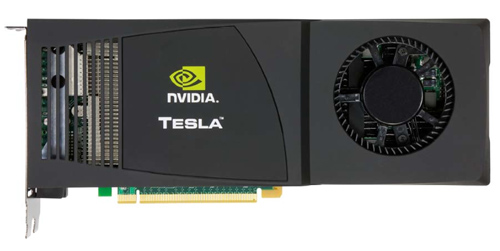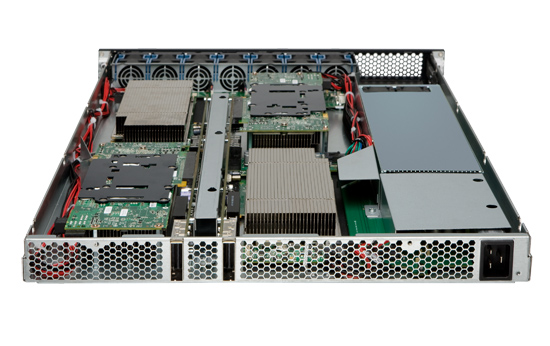NVIDIA's Fermi: Architected for Tesla, 3 Billion Transistors in 2010
by Anand Lal Shimpi on September 30, 2009 12:00 AM EST- Posted in
- GPUs
A Different Sort of Launch
Fermi will support DirectX 11 and NVIDIA believes it'll be faster than the Radeon HD 5870 in 3D games. With 3 billion transistors, it had better be. But that's the extent of what NVIDIA is willing to talk about with regards to Fermi as a gaming GPU. Sorry folks, today's launch is targeted entirely at Tesla.

A GeForce GTX 280 with 4GB of memory is the foundation for the Tesla C1060 cards
Tesla is NVIDIA's High Performance Computing (HPC) business. NVIDIA takes its consumer GPUs, equips them with a ton of memory, and sells them in personal or datacenter supercomputers called Tesla supercomputers or computing clusters. If you have an application that can run well on a GPU, the upside is tremendous.

Four of those C1060 cards in a 1U chassis make the Tesla S1070. PCIe connects the S1070 to the host server.
NVIDIA loves to cite examples of where algorithms ported to GPUs work so much better than CPUs. One such example is a seismic processing application that HESS found ran very well on NVIDIA GPUs. It migrated a cluster of 2000 servers to 32 Tesla S1070s, bringing total costs down from $8M to $400K, and total power from 1200kW down to 45kW.
| HESS Seismic Processing Example | Tesla | CPU |
| Performance | 1 | 1 |
| # of Machines | 32 Tesla S1070s | 2000 x86 servers |
| Total Cost | ~$400K | ~$8M |
| Total Power | 45kW | 1200kW |
Obviously this doesn't include the servers needed to drive the Teslas, but presumably that's not a significant cost. Either way the potential is there, it's just a matter of how many similar applications exist in the world.
According to NVIDIA, there are many more cases like this in the market. The table below shows what NVIDIA believes is the total available market in the next 18 months for these various HPC segments:
| Processor | Seismic | Supercomputing | Universities | Defence | Finance |
| GPU TAM | $300M | $200M | $150M | $250M | $230M |
These figures were calculated by looking at the algorithms used in each segment, the number of Hess-like Tesla installations that can be done, and the current budget for non-GPU based computing in those markets. If NVIDIA met its goals here, the Tesla business could be bigger than the GeForce one. There's just one problem:
As you'll soon see, many of the architectural features of Fermi are targeted specifically for Tesla markets. The same could be said about GT200, albeit to a lesser degree. Yet Tesla accounted for less than 1.3% of NVIDIA's total revenue last quarter.
Given these numbers it looks like NVIDIA is building GPUs for a world that doesn't exist. NVIDIA doesn't agree.
The Evolution of GPU Computing
When matched with the right algorithms and programming efforts, GPU computing can provide some real speedups. Much of Fermi's architecture is designed to improve performance in these HPC and other GPU compute applications.
Ever since G80, NVIDIA has been on this path to bring GPU computing to reality. I rarely get the opportunity to get a non-marketing answer out of NVIDIA, but in talking to Jonah Alben (VP of GPU Engineering) I had an unusually frank discussion.
From the outside, G80 looks to be a GPU architected for compute. Internally, NVIDIA viewed it as an opportunistic way to enable more general purpose computing on its GPUs. The transition to a unified shader architecture gave NVIDIA the chance to, relatively easily, turn G80 into more than just a GPU. NVIDIA viewed GPU computing as a future strength for the company, so G80 led a dual life. Awesome graphics chip by day, the foundation for CUDA by night.
Remember that G80 was hashed out back in 2002 - 2003. NVIDIA had some ideas of where it wanted to take GPU computing, but it wasn't until G80 hit that customers started providing feedback that ultimately shaped the way GT200 and Fermi turned out.
One key example was support for double precision floating point. The feature wasn't added until GT200 and even then, it was only added based on computing customer feedback from G80. Fermi kicks double precision performance up another notch as it now executes FP64 ops at half of its FP32 rate (more on this later).
While G80 and GT200 were still primarily graphics chips, NVIDIA views Fermi as a processor that makes compute just as serious as graphics. NVIDIA believes it's on a different course, at least for the short term, than AMD. And you'll see this in many of the architectural features of Fermi.










415 Comments
View All Comments
Zingam - Thursday, October 1, 2009 - link
No no! This is just on paper! When will see it for real!! Oh... Q2-3-4 next year! :)So you cannot claim they have the better thing because they don't have it yet! And don't forget next year we might have the head-smashing Larrabee!
:)
Who knows!!! I think you are way to biased and not objective when you type!
chizow - Thursday, October 1, 2009 - link
Heheh if Q2 is what you want to believe when you cry yourself to sleep every night, so be it. ;)Seriously though, its looking like late Q4 or early Q1 and its undoubtedly meant for one single purpose: to destroy the world of ATI GPUs.
As for Larrabee lol...check out some of the IDF news about it. Even Anand hints at Laughabee's failure in his article here. It may compete as a GPGPU extension of x86, but not as a traditional 3D raster, not even close.
SiliconDoc - Thursday, October 1, 2009 - link
Gosh you'd be correct except here is the FERMIhttp://www.fudzilla.com/content/view/15762/1/">http://www.fudzilla.com/content/view/15762/1/
There it is bubba. you blew your yap wide open in ignorance and LOST.
Good job, you've got plenty of company.
ClownPuncher - Thursday, October 1, 2009 - link
Wow, a video card! On top of that pcb could be a cat shit for all we know. The card does not exist, because I can't touch it, I can't buy it, and I can't play games on it.Also, the fact that you seem to get all of your info from Fudzilla speaks volumes. All of your syphillus induced mad ramblings are tiresome.
Lifted - Thursday, October 1, 2009 - link
I see what appears to be a PCB with some plastic attached, and possibly a fan in there as well. Yawn.ksherman - Wednesday, September 30, 2009 - link
Really like these kind of leaps in computing power, I find it fascinating. A shame that it seems nVidia is pulling a bit away from the mainstream graphics segment, but I suppose that means that the new cards from ATI/AMD are the undisputed choice for a graphics card in the next few months. 5850 it is!fri2219 - Wednesday, September 30, 2009 - link
For the love of Strunk and White, stop murdering English in that manner- it detracts from the text buried between banner ads.Sunday Ironfoot - Wednesday, September 30, 2009 - link
nVidia have invented a new way to fry eggs, just crack one open on top of their GPU and play some Crysis. :-)SiliconDoc - Wednesday, September 30, 2009 - link
Let's crack it on page 4. A mjore efficient architecture max threads in flight. Although the DOWNSIDE is sure to be mentioned FIRST as in "not as many as GT200", and the differences mentioned later, the hidden conclusion with the dissing included is apparent.Let's draw it OUT.
---
What should have been said 1st:
Nvidia's new core is 4 times more efficient with threads in flight, so it reduces the number of those from 30,720 to 24,576, maintaining an impressive INCREASE.
---
Yes, now the simple calculation:
GT200 30720x2 = 61,440 GT300 24576x4 = 98,304
at the bottom we find second to last line the TRUTH, before the SLAM on the gt200 ends the page:
" After two clocks, the dispatchers are free to send another pair of half-warps out again. As I mentioned before, in GT200/G80 the entire SM was tied up for a full 8 cycles after an SFU issue."
4 to 1, 4 times better, 1/4th the clock cycles needed
" The flexibility is nice, or rather, the inflexibility of GT200/G80 was horrible for efficiency and Fermi fixes that. "
LOL
With a 4x increase in this core design area, first we're told GT200 "had more" then were told Fermi is faster in terms that allow > the final tale, GT200 sucks.
--
I just LOVE IT, I bet nvidia does as well.
tamalero - Thursday, October 1, 2009 - link
on paper everything looks amazing, just like the R600 did in its time, and the Nvidia FX series as well. so please, just shut up and start spreading your FUD until theres real information, real benches, real useful stuff.